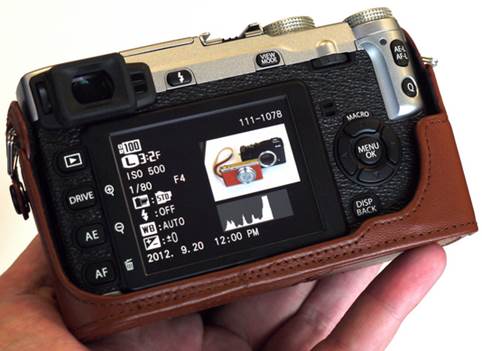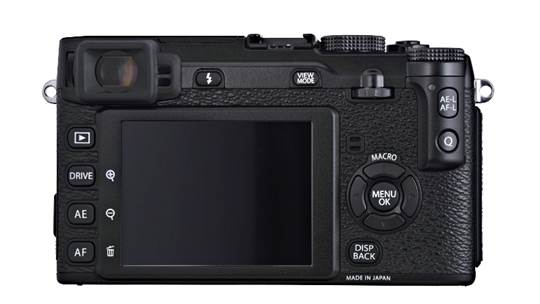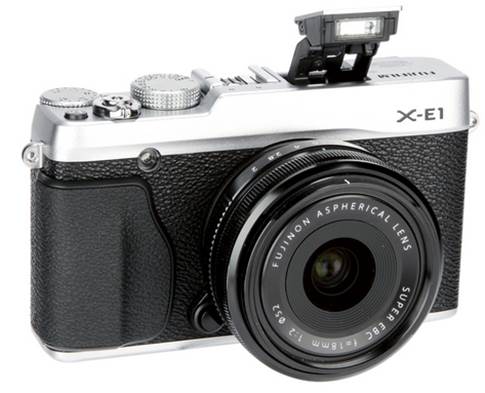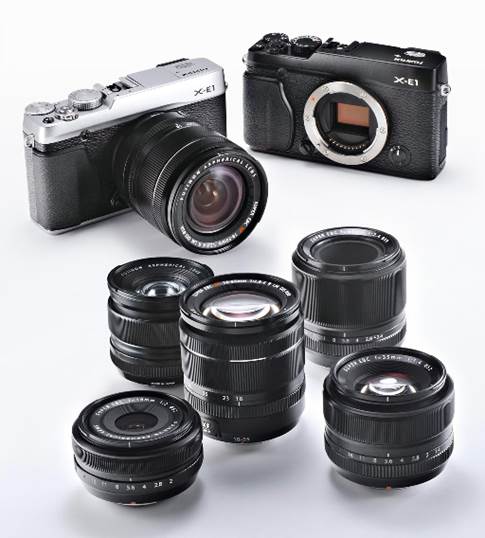As mentioned, one of the issues that came
to light when we tested the X-Prol was the relatively slow focusing speed
delivered. The X-E1, with its enhanced algorithms, promises to improve on this
and it’s fair to say it has. Focusing is much more prompt in single AF, with
only minimal hunting with the 18-55mm lens. But while it has been improved, the
AF performance still isn’t a match for similarly priced models such as the
Olympus OM-D, which tend to lock on noticeably faster than the X-E1 does. And
while it's hard to see the X-ETs intended use as a fast-moving action camera,
the continuous AF does struggle with moving subjects, relying solely on the
central AF point for focus.

That said, the 49-point AF arrangement
provides good coverage, though not to the edges of the frame, while the AF
point area provides the choice of five different sizes (set via the control
dial) depending on how precise you want to be with your focus. The combination
of hitting the AF button at the rear and the four-way d-pad is straightforward,
though maybe a little fiddly, while the 18-55mm delivers relatively quiet
focusing, though the other prime lenses still do tend to offer up the odd
mechanical whirr as focus is acquired.
Using the X-E1 it’s surprising how little
if at all you miss the clever hybrid viewfinder of the X-Prol. With the
class-matching 2.36m-dot resolution it’s a noticeable improvement on the
lower-resolution EVF in the X-Prol, and is far from tunnel-like when looking
through it. The OLED technology provides a wider ratio from black to white as
well as brighter colors that will see you soon forget about the missing optical
viewfinder.
The payback for the excellent EVF is the
somewhat disappointing 2.8in screen that doesn’t quite cut it on a camera of
this price. While more than acceptable, it just doesn’t deliver quite the same
razor-sharp results as rivals, while the absence of a vari-angled screen may be
disappointing to some.
E1 doesn’t become unnecessarily fiddly,
while the number of exterior controls sets the right balance of providing the
photographer with enough hands-on control while still maintaining a relatively
neat and easy-to-navigate layout. The Quick menu provides instant access to the
camera’s core settings, while it couldn’t be simpler or quicker to change
aperture and shutter speed.
There’s a host of drive modes on the X-E1,
so as well as single and continuous (a pretty impressive burst of 6fps), you
can bracket exposure, ISO, Film Simulation, Dynamic Range and Motion Panorama.

Shot
using the X-EVs DR200 mode, this has allowed more detail to be retained in the
highlights.
Value
At $1,746.1with the rather lovely 18-55mm
f/2.8-4 kit lens, the Fujifilm X-E1 goes right up against the similarly
retro-inspired 16MP Olympus OM-D, which comes in at the same price with the
slightly broader 12-50mm zoom though with a variable maximum aperture of
f/3.5-6.3. That’s not forgetting the 24MP Sony NEX-7 at around $1,442.2, though
both cameras' lenses can’t match the quality of the 18-55mm kit lens that comes
with the X-E1.
Image quality
Tone and exposure
The X-E1 uses the same 256-zone metering
system as the X-Pro1, providing Multi, Spot and Average metering modes.
With Multi metering selected, the images
from the X-E1 are hard to knock, with pleasingly exposed shots delivered in
almost every situation.
The X-E1 also benefits from two expanded
dynamic range settings, referred to as DR200 and DR400, with the aim to retain
detail information in the highlights of the image which can be an issue when
shooting high-contrast scenes. Working with both JPEGs and Raw files, shooting
in DR200 does see the X-El's base ISO increase to ISO 400. While ISO 800 will
be your base ISO if shooting in DR400, but the results are impressive, with
considerable highlight detail retained.
White balance and color
The X-E1 s Auto White Balance is a solid,
consistent performer in both natural and artificial light, producing neutral,
pleasingly saturated results throughout the ISO range.
With a nod to Fuijfilm's heritage, the X-E1
also features a host of film simulation modes to provide a slightly different
look to your images, including Velvia, Provia, Astia, Pro Neg.Std, Pro Neg.Hi
and mono modes.

Sharpness and detail
The sharpness and level of detail delivered
by the 16.3MP X-Trans CMOS sensor is nothing short of stunning, with the
absence of an anti-aliasing filter giving a level of achievable detail that
surpasses other APS-C based cameras that have a similar resolution.
Iso quality
Low ISOs are smooth and devoid of any signs
of image noise; it begins to encroach ever so slightly at ISO 800, but it's
very subtle. While image noise does become more apparent at ISO 3200, the level
of detail rendered is still good. At ISO 6400, results are still far more than
acceptable, and though noise is apparent, it has a pleasing film-like structure.
Verdict
While it may appear to be simply a
stripped-down, more affordable X-Prol to tempt more people into Fujifilm’s CSC
family, that would be doing the X-E1 a great disservice.
Similar in size to the XIOO, and combined
with a similar premium finish that won over so many fans to Fujifilm’s
retro-inspired compact, the X-E1 manages to feel more refined and balanced as
soon as you pick it up compared to the rather chunky X-Pro1.
And while it forgot the smart hybrid
viewfinder of the X-Prol, the payback is the sharper, crisper EVF in the X-E1
that more than makes up for this, though you could feel a little short-changed
with the fairly underwhelming rear screen.
The X-ETs AF, though improved from the
original X-ProTs focusing, is still not as fast or as responsive as the systems
found in its rivals, while the video capabilities aren’t as comprehensive
either.
These points aside, the X-E1 is a joy to
shoot with. The back-to-basics philosophy won’t be for everyone, but it means
it’s quick and easy to set-up and shoot with, while the Quick menu offers
access to other key shooting controls.
The real jewel in the crown of the X-E1 is
its sensor. The quality of the results and the detail rendered is excellent,
delivering images that are some of the best, if not the best, we’ve seen from
an APS-C sized sensor.
While it may be a bit more of a niche
camera than some other models, those who opt for the X-E1 will be rewarded with
a camera that looks the part, handles well and delivers images beyond what its
price may suggest.

While
it may be a bit more of a niche camera than some other models, those who opt
for the X-E1 will be rewarded with a camera that looks the part, handles well
and delivers images beyond what its price may suggest
|
Specifications
§ SENSOR:
16.3MP APS-C X-Trans CMOS sensor
§ OUTPUT
SIZE: 4896 x 3264px
§ FOCAL
LENGTH MAG: 1.5x
§ LENS
MOUNT: Fuiifilm X mount
§ FILE
FORMATS: Raw IRAF1. JPEG. Raw+ JPE6
§ COMPRESSION:
Larae. Medium & Small
§ COLOUR
SPACE: sRGB. Adobe RGB
§ SHUTTER
SPEEDS: 30-1/4000th second, Dlus Bulb
§ SHUTTER
TYPE: Focal Plane Shutter
§ MAX
FLASH SYNC: 1/180th
§ IMAGE
STABILISATION: No. lens-based
§ DUST
REDUCTION: Yes
§ ISO:
200-6400, extendable to IS0 100-25.600
§ EXPOSURE
MODES : P, S, A, M
§ METERING
SYSTEM TTL: 256-zones meterina
§ EXPOSURE
COMP: -1+2 EV in 1/3 steps
§ WHITE
BALANCE: Auto White Balance, Fine, Shade, Fluorescent light (Daylight],
Fluorescent light (Warm White), Fluorescent light (Cool White), Incandescent
light. Underwater, Custom, Color Temperature Selection
§ COLOUR
TEMP: 2500-10.000K
§ DRIVE
MODE: Single, Continuous (3 or 6fDs), self-timer
§ MOVIE
MODE : 1080 (24p)HD video & 720 (24)HD video
§ LCD:
2.8in. 460k-dot TFT LCD display
§ VIEWFINDER
TYPE: Electronic 2.36m-dot OLED color viewfinder
§ FIELD
OF VIEW: 100%
§ DIOPTRE
ADJUSTMENT: -4m to +2m
§ FOCUSING
MODES: Sinale and Continuous AF. MF
§ FOCUS
POINTS: 49 selectable points
§ LIVE
MODE: Yes
§ DOF
PREVIEW: Yes
§ PC
SOCKET: No
§ CABLE
RELEASE: Yes
§ BUILT
IN FLASH: Yes
§ MEMORY
CARD: SD/SDHC/SDXC
§ CONNECTIVITY:
HDMI, Hi-Speed USB & 2.5mm microphone connector
§ POWER:
Rechargeable Li-ion NP-W126 battery
§ WEIGHT:
350a
§ DIMENSIONS :
129 x 74.9 x 38.3mm
PROS
§ Stunning
image quality from the 16.3MP X-Trans CMOS sensor
§ Premium
finish and lovely design
§ The
EVF is so good you don't miss the X-Pro1's hybrid finder
§ No-nonsense
handling
CONS
§ While
the AF performance has been improved, it could still be faster to acquire
focus
§ The
2.8in rear screen is not a match for rival screens, both in terms of
resolution and the ability to change angle
|